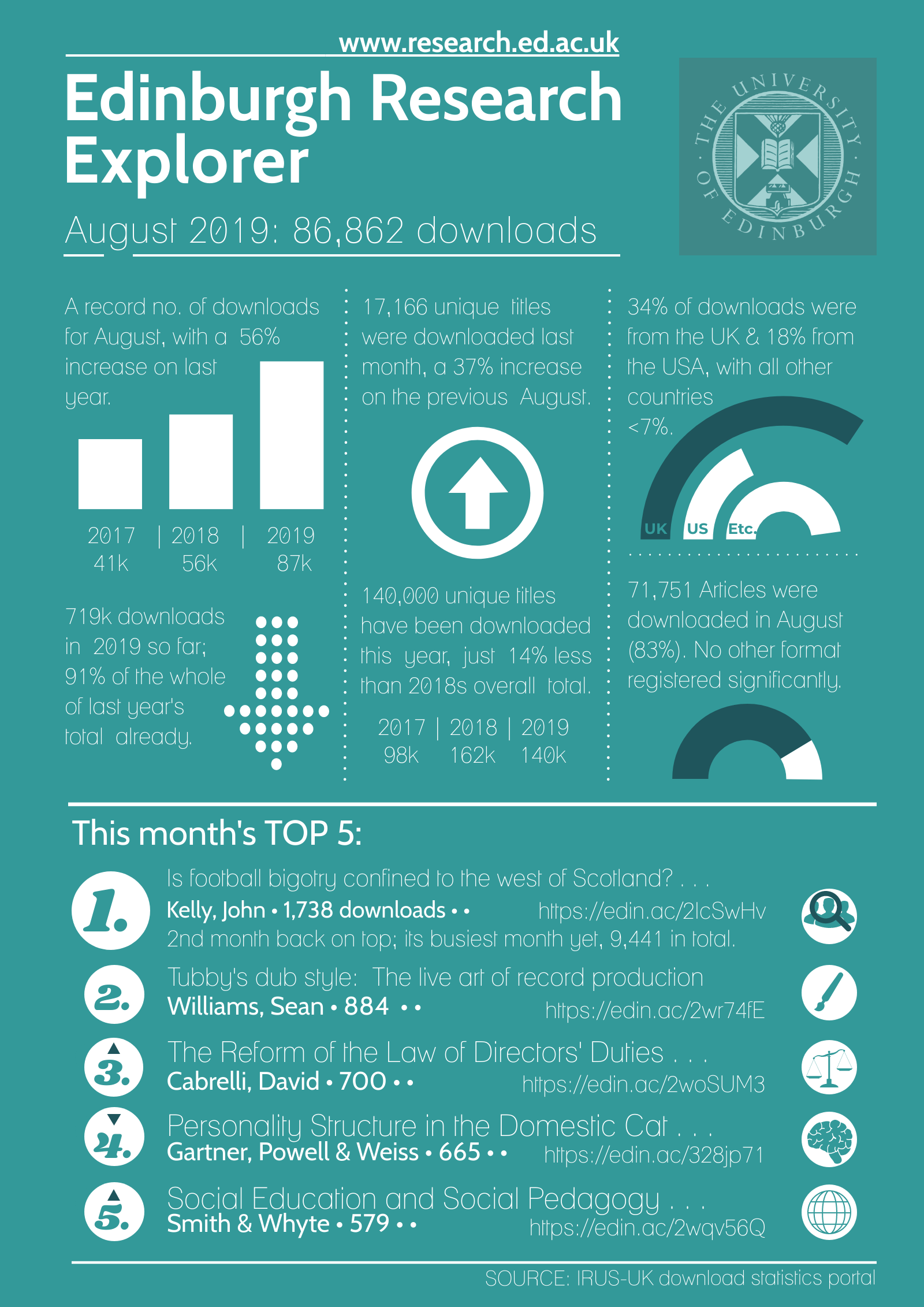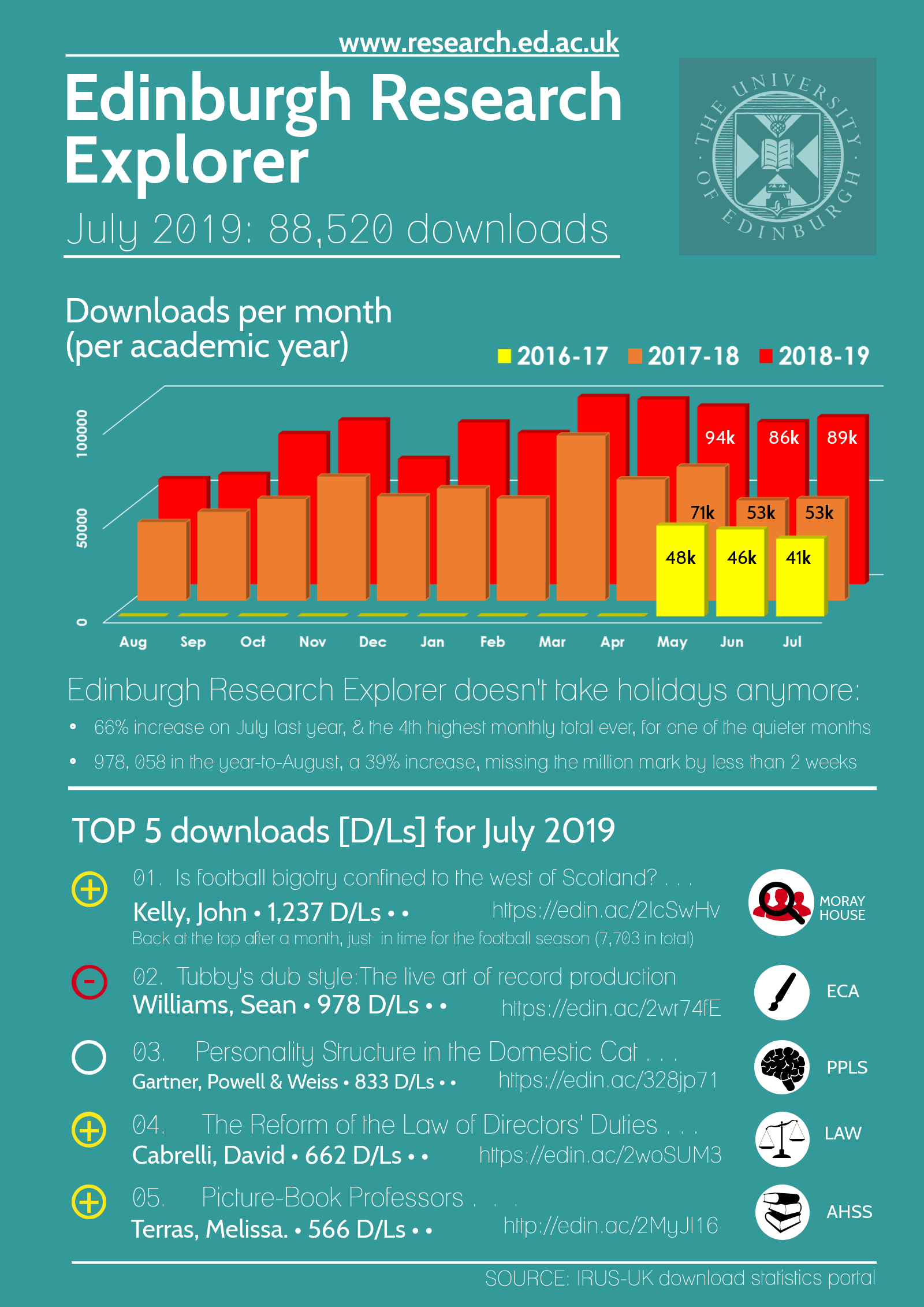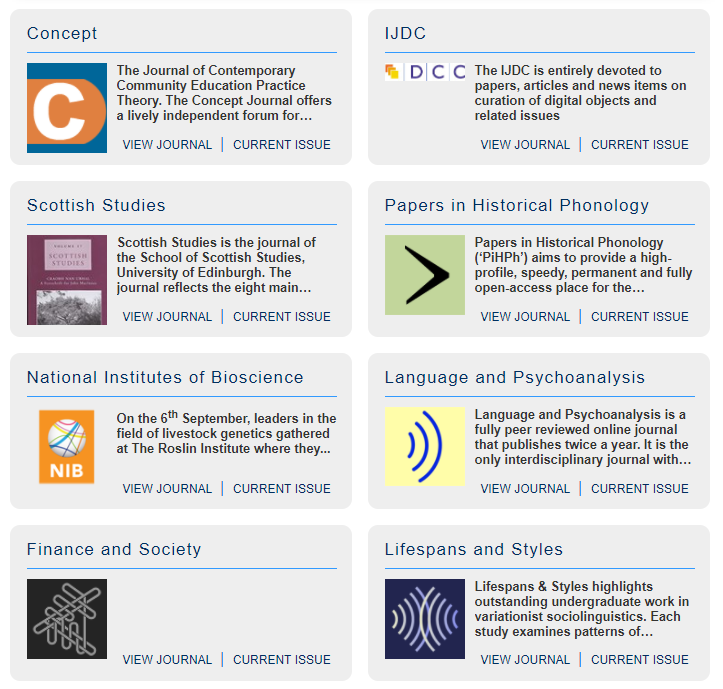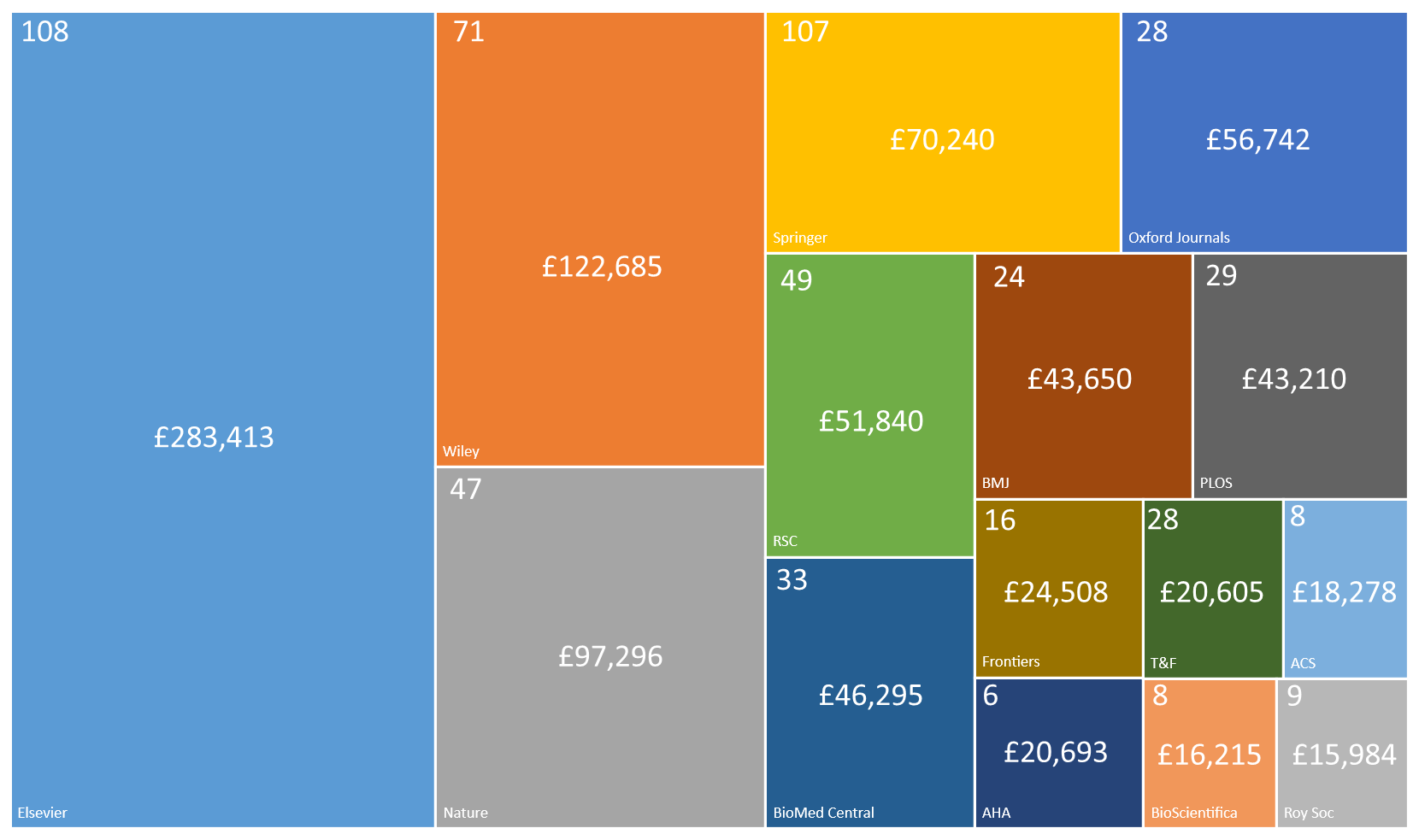Tag Archives: open access
Edinburgh Research Archive | ER-data: Jan. – June 2019

Edinburgh Research Archive • www.era.lib.ed.ac.uk • ERdata: Jan. – June 2019
The first half of 2019 saw the fifth highest total of downloads from ERA over a six-month period, unfortunately this is the lowest total of its ‘mature’ phase (since Jan-Jun 2017 download numbers have been consistently higher than 300,000 per 6-month block).

More disappointingly, this is the first time in ERAs history that we’ve witnessed a fall-off in numbers in two consecutive blocks: December 2018 saw a 15% decline and June 2109 has brought a further decline of 6.5%.
The remainder of this report aims to offer an overview of the last six-months of download activity on the Edinburgh Research Archive. Using data generated through the IRUS-UK download statistics portal to investigate that activity under the following headings:
[Also available as a PDF – 605kb]
Continue reading
Edinburgh Research Explorer Statistics: July 2019
Edinburgh Research Explorer | ER-data: Jan. – June 2019

Edinburgh Research Explorer • www.research.ed.ac.uk • ERdata: Jan. – June 2019
The first six-months of 2019, as now seems inevitable, have proved to be the busiest six-months in Edinburgh Research Explorer’s brief history, with 543,152 downloads. This is not only the first time that the half-a-million milestone has been breached within such a short period, but represents a 35% increase on the previous best. As the chart below indicates, this rate of growth is unprecedented following a full 6-months:

This report aims to offer an overview of the last six-months of download activity on Edinburgh Research Explorer. The data generated through the IRUS-UK download statistics portal is somewhat limited, it won’t tell us much about the users, in terms of who is downloading what, but it will offer up a few broad clues. This report will investigate those clues under the following headings:
[Also available as a PDF]
Continue reading
Open Access update
The University of Edinburgh is a strong supporter of open access (OA), and in 2018, researchers at Edinburgh published over 7,000 peer reviewed research outputs, of which over 5,181 (74%) are openly available from the University’s research portal (www.research.ed.ac.uk). As a large and diverse organisation there is naturally a large variation in the way in which we make our research openly available. From our total of 5,181 open access research outputs we find that 2,959 outputs (or 57%) are published as Gold OA – where the publisher makes the version-of-record open sometimes for a fee – and 2,222 (or 43%) are available as Green OA – where the author makes their accepted manuscript open from our Institutional or Subject Repositories for free.
Over the last 5 years the University has spent in the region of £5 million with publishers to make around 2,800 papers Gold OA. The majority of these papers were published as ‘hybrid OA’ in subscription journals where the publisher charges subscription fees to access the closed content, and also charges an open access fee to make individual papers open access. This practice of charging twice is called ‘double-dipping’ as large research intensive institutions have not seen their subscription costs lowered in proportion to their open access expenditure.
Over the last 5 years we have seen a period of significant consolidation of the open access publishing market with just three companies responsible for publishing 51% of Edinburgh’s journal articles, whilst receiving 57% of the money available for open access. The bulk of the University of Edinburgh’s RCUK block grants have been spent on ‘Hybrid OA’ journals as shown in the diagram below. Only 3 out of the 10 most popular publishers are purely Gold OA and don’t charge subscriptions :

Block chart showing the top 10 publishers who received funds from the RCUK open access block grant during 2013-2018. The number in the top left of each box is the total number of Gold OA papers published, the number in the middle of the box is the total expenditure and the name of the publisher is in the bottom left of the box.
Research funders like UKRI and the Wellcome Trust previously supported this ‘hybrid-OA’ model, but they no longer believe that it supports a transition to full OA which is their aim. To precipitate a change in the publisher’s behaviour and to increase the adoption of open access, a number of important European research funders, co-ordinated by Science Europe, developed Plan S.
Plan S update
Plan S requires that, from 2020, scientific publications that result from research funded by public money must be published in compliant Open Access journals, and specifically states that ‘hybrid OA’ journals won’t be supported. As it currently stands, Plan S will be hugely disruptive as researchers will potentially not be able to publish in their journal of choice.
In order to understand the impact of how Plan S will affect our research staff, departments and the broader academic community, Library & University Collections carried out a wide ranging consultation exercise. The Scholarly Communications Team held a series of eight open meetings, during the period 23rd – 30th January 2019, which were attended by over 260 staff. As far as we are aware this was the largest consultation held by a HE institution.
Based on feedback gathered at these meetings, the University has submitted a balance response to that is supportive of Plan S and the time frames set down, but also reflects the concerns raised about risks to international collaboration – specifically co-publishing work with collaborators in non-Plan S regions of the world. The response, and more general information about Plan S, can be read in full on our web pages:
https://www.ed.ac.uk/information-services/research-support/publish-research/open-access/plan-s
UKRI will decide how to apply the principles of Plan S once it has concluded an ongoing review of its own open-access policies, which is not likely to be completed until next autumn. The current Open Access policy is firmly in place until 31st March 2020 and it would be improbable for UKRI to change terms and conditions of grant awards midway through the year. We can therefore expect UKRI to adopt Plan S from 1 April 2020.
Academic-led publishing
Our last #openaccess week blog post finished with the observation that publishers are increasingly becoming in control of scholarly infrastructure, and that it is now more important than ever for academics to retain control over their research and publishing activities. To help with this we made the recommendation that Academic and National Libraries should support ‘low cost and no cost’ Gold OA – meaning open access initiatives that are inclusive and open to scholars who do not have budgets for publishing. To paraphrase Martin Eve who could articulate this better than I could ever hope to:
“….the economics of the humanities are different. The majority of research in the humanities remains unfunded except through institutional time. For this reason, Article Processing Charges are not a palatable option for these disciplines.“
Compared against STEM subjects and the lifesciences, commercial publishers have not made much headway with Gold OA in the arts and humanities disciplines. Partly in response, I believe in recent years this has led to lots of academic-led publishing initiatives being set up. You can read more in this excellent paper by Adema & Stone:
Open Library of Humanities
One of my favourite initiatives in the humanities is the Open Library of Humanities. It is funded through a model of library partnership subsidies which collectively funds the platform and its array of journals. A large number of libraries and institutions worldwide already support the OLH, which makes for a sustainable, safe platform.
The annual cost for supporting libraries is less than one Gold OA article processing charge which is excellent value for money – if you had £1000 would you prefer to provide open access to one article or for a whole suite of journals? If your institution hasn’t already signed up – you can check here (https://www.openlibhums.org/plugins/supporters/) – then I would wholeheartedly recommend that you sign up to be a supporting member. In fact, if you are from a larger institution then you should offer to support at a higher rate (which is STILL cheaper than one Hybrid Gold OA publishing fee):
University of Edinburgh further supports OLH
Edinburgh University Library Open Journals
Edinburgh University Library supports the publication of academic and student-led open access journals by providing a journal hosting service using the Open Journal Systems software. The Open Journal service is available to University of Edinburgh students and academics and is provided free of charge.
The Library helps with the initial set up of all new journals and provides ongoing support. We:
- Provide the service free of charge on the condition that journals requirements can be met without additional cost or time to the Library.
- Provide advice and support to help editorial teams set up their journal and training on using OJS
- Provide limited customisation of the new journal according to the design brief supplied by the journal editorial team. Provide initial training and documentation and ongoing support
- Provide training (as required) for new publishing staff
- Consult with experts in the Library to offer copyright advice
- Set up a Google Analytics account for each journal. Please note, the Library may make appropriate use of the statistical data
- Manage (and pay for) Digital Object Identifiers (DOIs) which use the Library’s DOI prefix: 10.2218
- Apply for an ISSN on behalf of the journal
- On publication, apply to DOAJ (Directory of Open Access Journals).
Currently there are 16 journals on the platform and we are looking to grow the service over the new two years.
Green open access and REF compliance
Yesterday’s blog post suggested that our reliance on Hybrid Gold Open Access to meet research funder’s open access requirements was too expensive and libraries should be supporting alternative pathways. In terms of pure numbers the main way the University of Edinburgh is making access to it’s research open is via Green Open Access (OA) – where the Author’s Accepted Manuscript (AAM) version of the research output is deposited in a repository and made available as soon as publishers copyright policies allow.
Since we started compiling monthly reports in 1st April 2016 we have made 6266 journal articles and conference proceedings open access which equates to around 92% of the University’s total output.
The University of Edinburgh has always had a preference for Green OA because there are no upfront costs for authors so everyone can participate without requiring access to large research budgets. But since the REF2021 open access requirements were published, Green OA has become even more important. The HEFCE policy states that, to be eligible for submission to the next REF, authors’ final peer-reviewed manuscripts must be deposited in a repository. The University of Edinburgh has adopted this policy and provided the infrastructure and support for all it’s researchers to make their research Green OA. The programme which was adopted to facilitate open access in the University of Edinburgh’s College of Medicine and Veterinary Medicine is described in more detail in the following paper:
The results of the open access implementation plan have been extremely successful and we can report a 92% adoption rate for Green OA. The Scholarly Communications Team prepares monthly reports using data from our repository to identify the current level of compliance with the REF open access policy. These monthly reports indicate the numbers of in-scope research outputs (journal articles and conference proceedings with ISSNs) and whether they meet the requirements for the next REF, as per our repository’s compliance-checker functionality.
The figure and table below show the growth in the percentage of research outputs made open access since April 2016 and also a more detailed breakdown by subject area. The reporting period is a rolling window three months behind the current date.
| 1 April 2016 – 31 May 2017 | Number of papers | Indicative compliance |
| Arts, Humanities & Social Sciences | ||
| Business School | 123 out of 126 | 97.62% |
| Divinity, School of | 22 out of 22 | 100% |
| Economics, School of | 21 out of 21 | 100% |
| Edinburgh College of Art | 111 out of 118 | 94.07% |
| Health in Social Science, School of | 118 out of 125 | 94.40% |
| History, Classics and Archaeology, School of | 86 out of 88 | 97.73% |
| Law, School | 102 out of 104 | 98.08% |
| Literatures, Languages and Cultures, School of | 59 out of 61 | 96.72% |
| Moray House School of Education | 155 out of 160 | 96.88% |
| Philosophy, Psychology and Language Science, School of | 402 out of 405 | 99.26% |
| Social and Political Science, School of | 181 out of 191 | 94.76% |
| Medicine & Veterinary Medicine | ||
| Clinical Sciences, Deanery of | 1183 out of 1387 | 85.29% |
| Biomedical Sciences, Deanery of | 214 out of 239 | 89.54% |
| Molecular, Genetic and Population Health Sciences, Deanery of | 794 out of 910 | 87.25% |
| Veterinary Studies, Royal (Dick) School of | 550 out of 573 | 95.99% |
| Edinburgh Medical School | 672 out of 732 | 91.80% |
| Centre for Medical Education | 7 out of 8 | 87.50% |
| Science & Engineering | ||
| Biological Sciences, School of | 407 out of 455 | 89.45% |
| Chemistry, School of | 203 out of 231 | 87.88% |
| Engineering, School of | 373 out of 385 | 96.88% |
| GeoSciences, School of | 354 out of 373 | 94.91% |
| Informatics, School of | 366 out of 376 | 97.34% |
| Mathematics, School of | 135 out of 135 | 100% |
| Physics and Astronomy, School of | 340 out of 380 | 89.47% |
| Edinburgh Parallel Computing Centre | 6 out of 7 | 85.71% |
Problems
Despite a hugely successful Green OA implementation programme at the University of Edinburgh there are a number of significant outstanding problems. To my mind the main issues are that Green OA is:
Not immediate. Most publishers (but not all) require an embargo period of between 12-36 months before the AAM can be made open access. Not only are long embargo periods are hugely detrimental for scholarly communication, but I believe they are unnecessary. Many academic publishers insist on long embargo periods to protect journal subscription revenue from cancellations. However, a number of academic publishers (including the Royal Society, Cambridge University Press, Emerald and SAGE) have zero month embargoes for selected titles are they are not unduly affected by cancellations.
Not compliant with all research funders policies. Unfortunately, these long embargo periods are not compliant with all research funders policies (e.g. RCUK) which means that many researchers are forced to pay Hybrid OA fees for their publications. As we discussed yesterday Hybrid OA accounts for 70% of our open access expenditure. In the UK researchers are faced by a myriad of different funders policies (e.g. HEFCE, RCUK, Horizon 2020) which currently require different routes to open access.
Not cost-free. If you factor in hidden costs – such a repository platform fees and staff costs for mediated deposits/copyright checking – Green OA is more expensive than you would initially imagine. Whilst gathering data for a recent HEFCE open access questionnaire we estimated that we have around eleven full time equivalent staff distributed across the entire University working on open access implementation. If you aggregate all these costs then the cost per paper to deliver Green OA is somewhere in the region of £45 which I think is too expensive (but put in context this is still pretty good value for money as our average Gold OA costs are £1,676 per paper).
In summary, Green OA is a step in the right direction but still does not answer all of the problems that we currently face. What we can do to alleviate the issues of long embargo periods, harmonising research funders policies and simplifying processes and thereby lowering costs is the topic of tomorrows blog post – the UK Scholarly Communications Licence.
University of Edinburgh 2016/17 Gold open access spend analysis
The University of Edinburgh receives two main block grants from Research Councils UK (RCUK) and Charity Open Access Fund (COAF) to support researchers funded by them to comply with their open access policies. The Library’s Scholarly Communications Team manages these block grants on behalf of the institution. In 2016/17 we spent £1,167,966 to make 697 articles open access via the Gold open access route. In addition, £28,951 was spent on other publication costs, for example page and colour charges.
A summary of the open access charges made to the top 15 publishers is shown in the table and figures below:
| Row Labels | Count of APC paid | Sum of APC paid (£) | Ave APC (£) |
| Elsevier | 108 | £283,413 | £2,624 |
| Wiley | 71 | £122,685 | £1,728 |
| Nature | 47 | £97,296 | £2,070 |
| Springer | 107 | £70,240 | £656 |
| Oxford Journals | 28 | £56,742 | £2,026 |
| Royal Society of Chemistry | 49 | £51,840 | £1,058 |
| BioMed Central | 33 | £46,295 | £1,403 |
| BMJ Publishing Group Ltd | 24 | £43,650 | £1,819 |
| Public Library of Science | 29 | £43,210 | £1,490 |
| Frontiers | 16 | £24,508 | £1,532 |
| American Heart Association | 6 | £20,693 | £3,449 |
| Taylor & Francis | 28 | £20,605 | £736 |
| American Chemical Society | 8 | £18,278 | £2,285 |
| BioScientifica | 8 | £16,215 | £2,027 |
| Royal Society Publishing | 9 | £15,984 | £1,776 |
Points and trends to note:
- Our overall spend on open access in 2016/17 was £1,167,966 which bought 697 papers, with an average Article Processing Charge (APC) of £1,676.
- The open access expenditure is dominated by three large publishers: Elsevier, SpringerNature and Wiley. These 3 publishers account for 53% of our total spend. Note that we have shown SpringerNature as three individual publishers in the table and figure as they have distinct publishing identities – Springer, Nature and BioMedCentral.
- The top individual publisher (Elsevier) alone accounted for 24% of the total spend, with their APCs 56% more expensive than the average.
- Generally speaking, we found the highest individual APCs were from US society publishers, like the American Heart Association or American Chemical Society.
- Best value APCs were from publishers where we have offsetting or national agreements with – for example Taylor & Francis, Springer and Royal Society of Chemistry.
- 70% of our expenditure is on Hybrid Gold OA – where journals charge a subscription and APCs – rather than pure Gold OA (30%) where APCs are the only charge.
- Looking at the whole dataset Hybrid Gold OA is more expensive (£2,075) than pure Gold OA APCs. (£1,581).
Discussion
The University of Edinburgh publishes 6 -7,000 journal articles and conference proceedings per year. In the current market conditions if we were to fully transition to Gold OA then we estimate it would cost in the region of £10M per year. To put this in context Edinburgh University Library spends approximately £4M per year on e-journal subscriptions so this represents a significant uplift on the total cost of publication. I suspect this figure is similar for other research-intensive universities.
At its current scale and intensity, open access as purely delivered by Hybrid Gold OA and Gold OA alone is not likely to happen. Any increase to the total cost of publication is not acceptable.
If we wish to transition to full open access then significant cost mitigation for paid open access needs to occur, and alternative low cost or no cost options need to be investigated and adopted. Some options are described below.
Reducing cost recommendations
- Push for offsetting deals : Libraries should be a) requesting offsetting deals, b) pushing for significant discounts, and c) helping publishers adopt transformative business models.
Examples of publishers offering good offsetting schemes are IOP – where an actual rebate is given depending on Gold OA spend – and SAGE Publishing who globally discount the subscription rate of journals where more than 5% of articles are published as Gold OA. SAGE also offer steep open access discounts of 80% for some members of consortia subscriptions. Taylor & Francis are another publisher which significantly reduce APC cost (by 75%) to consortia members. These steep discounts are welcome, but have a fundamental problem in that they rely on privilege. Discounts are not available to all authors as they rely on institutions having a subscription.
Transformative business models such as the UK Springer Compact national agreement, or the Royal Society of Chemistry Read and Publish agreement, are also welcome as they lower transactional barriers for authors to participate in Gold OA. This leads to a greater coverage of open access articles in journal titles, rather than the patchy open access that Hybrid Gold OA delivers. The overall costs are also appreciably lower than the cumulative costs seen with Hybrid Gold OA – look at the difference in our expenditure between Elsevier and Springer for a similar amount of Gold OA articles published.
- Support ‘low cost and no cost’ Gold OA : Academic and National Libraries should support open access initiatives that are inclusive and open to scholars who do not have budgets for publishing.
Gold OA does not necessarily equate to paid open access. Many academic or library-led publishing initiatives do not charge Article Processing Charges as the costs are covered through alternative mechanisms. Some examples of innovative academic or library-led publishing activities are described below.
Edinburgh University Library provides an Open Journal Service which is available free of charge to University of Edinburgh students and academics. It provides a hosting platform for academic and student-led groups to create and publish their own Open Access journal. Currently the service has a portfolio of 16 journals and is looking to grow and develop in the coming year.
The Open Library of Humanities (OLH) is a charitable organisation dedicated to publishing open access scholarship with no author-facing article processing charges. The OLH publishing platform supports academic journals from across the humanities disciplines, as well as hosting its own multidisciplinary journal. The University of Edinburgh has opted to support the Open Library of Humanities at a higher rate than required. This additional support will enable the OLH to continue its growth mission to convert subscription journals to a solid, ongoing, open-access model, with no author-facing charges.
- Reduce reliance on Hybrid Gold OA : Hybrid Gold OA – where journals charge both subscriptions and Article Processing Charges – is too expensive.
Unfortunately, Hybrid Gold OA which accounts for 70% of our expenditure are significantly more expensive than pure Gold OA costs. It is not uncommon to receive invoices of $5,000 for individual APCs. Our open access block grants are supported either directly by taxpayers money (RCUK), or from charitable organisations (COAF), so it is imperative that anyone managing these funds should be seeking best value for money. I would find it very difficult to explain to someone who has raised money for Cancer Research UK the hard way by running the London Marathon that their sponsorship money has only paid for half an APC. Where research funders policies allow we should be seeking to reduce our reliance on Hybrid Gold OA by utilising alternative mechanisms like Green OA, which we will visit in more detail in tomorrow’s blog post.
20,000th item in the Edinburgh Research Archive
We are delighted to announce the deposit of the 20,000th item into our institutional repository the Edinburgh Research Archive (ERA). ERA is a digital repository of original research which contains documents written by academic authors based at, or affiliated with, the University of Edinburgh that have sufficient quality to be collected and preserved by the Library, but which are not controlled by commercial publishers. Holdings include full-text digital doctoral theses, masters dissertations, project reports, briefing papers and out-of-print materials.
Our milestone 20,000th item is a PhD thesis written by Susan Ahrens at the Moray House School of Education and was awarded in 2016:

2016 Homeless World Cup in Glasgow : image courtesy of the BBC (http://www.bbc.co.uk/news/uk-scotland-36819350)
This work investigates the relationship between sport, homelessness and poverty, and considers the way two social enterprises – the Homeless World Cup and Street Soccer (Scotland) – help overcome homelessness and its associated effects.
APCs paid in the wild
As part of the Lessons in Open Access Compliance for Higher Education (LOCH) project we have been looking at the problems of identifying Article Processing Charges (APCs) that the Library is not currently aware of – which we colloquially call ‘APCs paid in the wild’. We have written a short case study that is currently under open review at The Winnower:
Improving estimates of the total cost of publication by recognising ‘APCs paid in the wild’
The take home message from our ‘APCs paid in the wild’ case study can be summarised as:
We estimate that these costs could account for up to 20% extra in the total cost of publication that is not currently being accounted for. This additional cost is important to take into account when institutions are negotiating fair offsetting agreements for open access publishing.
We would welcome any constructive criticism on the work so please have a read and leave an open review so that we can improve the article.






